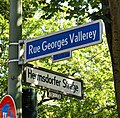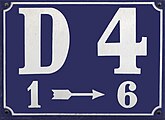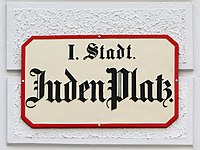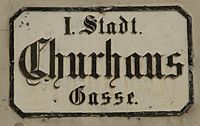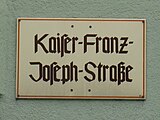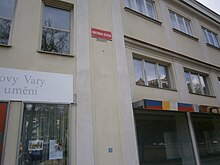Road sign

A street sign (in Germany according to § 45 Abs. 3 Satz 1 StVO : " Street name sign ") shows the street name of a street . Street signs are attached to street crossings or junctions on house walls or free-standing posts.
Germany

The road signs in Germany are designed differently from region to region, including the following types:
- black sign with white inscription
- white sign with black inscription
- blue sign with white inscription
- red and blue signs with white inscription
- orange sign with white inscription ( Kiel )
- green sign with white inscription
- red signs with white inscription
The design is standardized by the municipal road construction authorities.
Street name signs, referred to as sign 437, must always be labeled on both sides with retroreflective foil RA1. The standard colors are traffic blue RAL 5017 and traffic white RAL 9016. The labeling is to be carried out in DIN 1451 Part 2. The minimum font height is 84 mm. The lower edge of the shield is at least 2 meters high, 220 cm over bike paths.
Berlin
There are two types of street signs in Berlin : a West Berlin and an East Berlin variant, which is due to the division of Germany. Both versions have black lettering on a white background, but differ in the font: The West signs are particularly noticeable because of their characteristic ß in -straße , and there is also a tz- ligature ; the letters on the east signs are much narrower.
The road construction authority has chosen the West-Berlin variant and is gradually replacing the old East-style signs with West-style signs, where this is necessary due to damage, construction work or renaming. The West Berlin variant can also be found in some West German cities.
In addition to these standard types, street signs in historical style are used in certain quarters, such as in the old town of Spandau. On the other hand, some of the private roads in colonies are marked with differently designed and colored road signs, as in the garden colonies in the Pankow district.
The font of this "total Berlin variant" is the "Thannhaeuser Fraktur", created by Herbert Thannhaeuser (1897 to 1963)
In the former French Allied settlements (such as the Cité Foch ) the streets have French names and are signposted with a blue sign and white lettering based on the French model.
In Berlin, these signs often replace the parking space sign, a square with a blue background and a white P. These street signs therefore have two functions here.
Road sign and parking space marking.
If you turn into flowing traffic from a road marked in this way, you have to grant the right of way in all directions. In the parable, it's like pulling out of a parking pocket.
Example of a West Berlin street sign with an angular ß
Example of an East Berlin street sign with a round ß
Example of an old Berlin street sign
French street sign in the Cité Foch
When the ideas for street names run out: "Straße 265" in Berlin-Gatow
Historically modeled sign on the Berlin imperial oak
Kaiserslautern
In Kaiserslautern , the city was divided into fifths , which were differentiated by color , until the 1970s . The signs attached to house walls with a blue, white, yellow, red or green base color are partly still there and give an approximate impression of which part of the city you are currently in. Today only white signs with black letters are put up everywhere.
Mainz
In downtown Mainz there have been street signs with white letters on a blue or red background since 1853. Roads with blue signs run parallel to the Rhine, those with red signs to the Rhine. The house numbers increase in the streets with red signs in the direction of the Rhine , in the streets with blue signs with the direction of the river, even numbers on the right and odd numbers on the left. Those who are more or less familiar with the area are able to quickly estimate the approximate position of a house number in the street. The suggestion for this was given by Josef Anschel as early as 1849 with an application to change the house numbers .
Mannheim
As a planned city, the horseshoe-shaped city center of Mannheim is not laid out in streets, but in blocks of houses, the squares . Although these are not squares in the sense of geometry , they are quadrilaterals . The addresses are not formed by streets, but by square names with associated house numbers (for example D 4, 1 ). The house numbers run around the respective square so that, for example, D 4, 6 is on the same street opposite E 4, 1 . At the corners of the squares there are street signs for the respective sides, which designate the square and also indicate which house numbers are on this side.
Munich
With Munich is associated, among many others, the enamel panels with white text on a blue background. In their current form, they date from the 1980s and have replaced signs with Munich traffic writing that Otl Aicher designed. Blue signs on a white background (the Bavarian colors) have been around since the beginning of the 20th century.
Other forms in Germany
Road sign after the spelling reform
Unofficial Hamburg street sign that Wikipedia cites as a source
Street sign in Borschemich .
Marler street signs with house number counting
Shield with legend board, Recklinghausen
Switzerland
In Switzerland the street signs (locally in the spelling street signs ) are mostly designed in light font on a (dark) blue background. The writing can be framed by a simple, rectangular or a slightly decorated frame. Signs with raised letters are often used, but printed and enameled signs are also used.
Bern
In the old town of Bern , the street signs are not blue, but have been in the five colors white, black, green, red and yellow since 1798. After the Napoleonic troops marched into Bern in 1798, the commander-in-chief of the French invasion troops , General Schauenburg , gave the order to make street signs for the five districts, in different colors. However, the legend also developed that the signs were of different colors so that the French soldiers could find their way to their night quarters more easily after their drinking bouts.
France
In Strasbourg, the capital of Alsace , the street signs in white on a blue background are bilingual: in French and the local, widespread dialect there, Alsatian , an Alemannic dialect of German.
Bilingual street signs in Strasbourg ; the historical German name is Jungferngasse.
Italy
In Italy , the street signs in many places are white with black inscriptions and a thin blue border, in South Tyrol they usually still have the municipal coat of arms and are bilingual. In the center of Rome and in the older districts outside of it, however, the street signs are usually engraved marble plaques and often contain, in addition to the street name, a reference to the district (Rione) and a reference to the name of the street (e.g. "Astronomer" or "Writer" ").
Via Appia Antica in Rome
Johann-Wolfgang-von-Goethe-Strasse in Bozen (South Tyrol)
Via Anne Frank in Merano
Quattro cantoni in Siena
Piazza martiri d'Ungheria 1956 in Capri
Corte Contarini in Venice
Luxembourg
Austria
Vienna
There are numerous variants of road signs in Austria . In Vienna the system of street signs was very well thought out. The streets have been named since 1862. Before that, the houses were simply numbered consecutively. The signs show the number of the district and the name of the alley. The signs of the streets leading out of the center were angular, those of the other alleys were round. The signs in Vienna's 1st district were generally angular. The inscription was black. The edges were of different colors:
- I. District: Red
- District II: violet
- III. District: Green
- District IV: Rosa
- V. District: Black
- VI. District: Yellow
- VII. District: Blue
- VIII. District: Gray
- IX. District: Brown.
After the incorporation in 1890 and 1892, the new districts received 10 to 19 signs with a red border. The house numbers were structured according to the same scheme. From 1920 to 1923 all signs had a red border, signs for squares had red letters, those of streets had black letters. Since 1923 the signs have been blue with white inscription and instead of Fraktur, antiqua is used. Between 1926 and 1945 they tried again with square and round panels. Today's signs are similar to those from 1923. Characteristic is the fact that the district is given without exception in Arabic numerals in front of the street name. Since the 1980s, more and more old panels have been attached to old ensembles according to the guideline of 1863, some of them are amateurish, including the incorrect spelling of the Fraktur-s .
Street sign and house number in Hietzing
Graz
In Graz the street signs are traditionally in green with white letters. In the middle of the head there is the district name and the district number (in Roman numerals), below is the street name.
innsbruck
The oldest street signs in Innsbruck are light yellow with black Fraktur font , have a thin red line along the edge and were in use across the board until 2008, mostly on the facades.
In the inner city area, narrow white signs with black letters and red frames were also attached to posts in the 1900s .
Since 2008, starting in the city center, all street signs have been gradually replaced by new ones with white letters on a wine-red background. Additional explanations about the origin of the street name are given on these boards.
The city of Innsbruck is giving the old, yellow boards away to selected institutions that are related to the street name or are auctioned off to interested parties.
Linz
In Linz there are old street signs, which are made of black metal signs with white writing on wooden panels. In 1951, Friedrich Neugebauer and his master class at the Linz Art School designed the font (digitized by CAT Linz ), which was in use until the 1990s. The new street and house number signs are white with black letters in the Weidemann font and have an orange line above and below and the coat of arms of the city of Linz on the left. On the new boards, there are usually additional explanations about the origin of the street name.
Poland and the Czech Republic
In Poland there were street signs in large cities as early as the early 19th century ( attested by Johann Gottfried Seume for 1802). There is no standard for the design of street signs that is valid in all of Poland, and so the palette ranges from historical-looking enamel signs with white serif antiqua on a dark blue ( Międzyzdroje ) or dark green ( Krakow ) background to the very modern-looking Warsaw signs.
In the Czech Republic, mainly red street signs with white letters are to be found. The street names are inserted in capital letters and the signs are outlined in white. The Czech tradition is based on Austrian roots .
Great Britain and Ireland
Most of the road signs in the Republic of Ireland and in some regions in Scotland are bilingual (in English and Irish or Scottish Gaelic ). In the Gaeltachtai of the Republic of Ireland, street signs are usually purely Irish. There, all roads are legally required to be written in Irish.
In the Republic of Ireland, the signs are mostly in white letters on a blue or green background. In the city of Dublin, similar to Vienna, the corresponding city or postal district is indicated (24 districts in Dublin) on the right-hand side of the street sign.
North America and Australia
In North America and Australia , road signs have white letters on a green background. An exception to this are some metropolitan regions, where different cities that structurally merge into one another use different street signs. This makes it possible for people who are not in the area to see where you are and which of the very different police regulations apply. An example is the Los Angeles metropolitan area : Los Angeles white on blue, Beverly Hills black on white, Santa Monica white on blue with an orange bottom border. Another example is the San Francisco Bay Area : Oakland has an oak on the green sign, Berkeley uses white lettering on a brown background and Dublin has a shamrock.
See also
Individual evidence
- ↑ Roads reserved for pedestrian traffic were signposted in this way until the regulation was amended on April 10, 2015, many of these signs are still hanging, cf. Section 1 (1) sentence 2 statute of the state capital Kiel on street signs and property numbers from March 21, 1969, last amended by the 2nd supplementary statute of December 20, 1984, PDF on kiel.de with the statutes of the state capital Kiel on street signs and property numbers from 10 April 2015
- ↑ VwV - StVO §§39 - 43III
- ^ Mainz Online: Street signs
- ↑ Known as the Bernese color . In: Der Bund , July 19, 2010
- ^ History of street names in Vienna
- ↑ CAT Linz , www.peter-wiegel.de
- ↑ Official Journal of the City of Linz No. 1 of January 10, 2005
- ↑ Conscription and orientation numbers in Austria and the Czech Republic: Keyword Czech Republic
Remarks
- ↑ The font for Berlin street signs, which was probably created in the 1930s, was only used in the western part after the city was divided. In the 1950s, the eastern part got a narrow-running sans serif with technical characteristics. Both fonts were documented, interpreted, supplemented and digitized in 2000 by the Berlin designers Ole Schäfer and Verena Gerlach . The fonts were published by FontShop as FF Cst Berlin West and FF Cst Berlin East .
- ↑ Since the adjacent buildings, which originally carried the street sign, will be demolished in the near future, this provisional street sign was hung until the place was finally demolished.
literature
- Peter Guttkuhn: Lübeck historical street signs . In: Vaterstädtische Blätter, Lübeck. 35th vol., 1984, p. 37.




